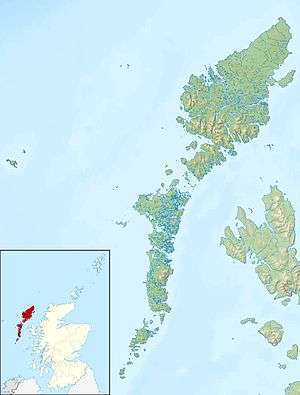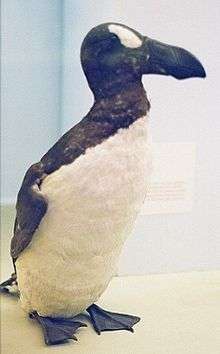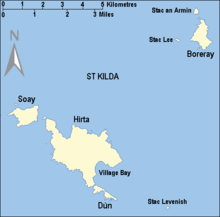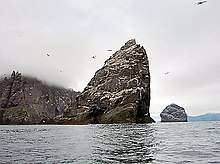Stac an Armin
Stac an Armin (Scottish Gaelic: Stac an Àrmainn), based on the proper Scottish Gaelic spelling (formerly àrmuinn), is a sea stack in the St Kilda archipelago. It is 196 metres (643 ft.) tall, qualifying it as a Marilyn.[4] It is the highest sea stack in Scotland and the British Isles.[5][6][7]
| Gaelic name | Stac an Àrmainn |
|---|---|
| Meaning of name | (Gaelic) "stack of the warrior" |
| Location | |
 Stac an Armin Stac an Armin shown within the Outer Hebrides | |
| OS grid reference | NA151064 |
| Coordinates | 57.88°N 8.49°W |
| Physical geography | |
| Island group | St Kilda |
| Area | 9.9 ha (24 acres) |
| Highest elevation | 196 m (643 ft) |
| Administration | |
| Sovereign state | United Kingdom |
| Country | Scotland |
| Council area | Outer Hebrides |
| Demographics | |
| Population | 0 |
| References | [1][2][3] |
The name Stac an Armin means stack of the soldier/warrior, and evidence remains showing it was used by people living nearby as a hunting grounds. It is not believed to have been inhabited year round, but has hosted some (involuntary) extended stays. Climbing the rocks was once done to collect eggs and has continued in the form of recreational sport. The island was once home to the now extinct great auk, and rules exist to protect the bird habitats and breeding grounds.
Stac an Armin is 400 metres (¼ mi) north of Boreray and near the 172-metre-high (564 ft) Stac Lee. Stac an Armin is separated from Boreray by a channel "so littered with rocks" that it should not be sailed,[8] though sailors write passionately about the views.[9]
History and people
The first written account of the island was Martin Martin's description in the early 18th century. Martin wrote about the island after the Scottish writer had visited St Kilda in 1697 and included a few anecdotes about the stack in his A Description of the Western Isles of Scotland published in 1703. It was the first comprehensive book on the archipelago, to which was appended "A Late Voyage to St Kilda". Martin calls the island "Stack-Narmin."[10]
It was never inhabited full-time, but hunting its bird population helped sustain the way of life of the population of St Kilda, as evidenced by the buildings they left behind. There are no fewer than 78 storage cleitean on Stac an Armin and a small bothy, built by the St Kildans. Martin describes these cleitean as "pyramids" and wrote they were used to "preserve and dry" birds, especially the "solan goose" (northern gannet). Martin observed one harvest that brought in 800 birds.[10] In addition to the geese, the islanders used Stac an Armin for harvesting great auks, gannets, and puffins, as well as their eggs.[11] The numerous birds that lived on the island were an important source of sustenance for the people of St Kilda.[12]
The longest recorded period anyone ever spent on the island was about nine months. Three men and eight boys from Hirta were marooned here from about 15 August 1727 until 13 May 1728. As luck would have it, Hirta suffered a smallpox outbreak while the eleven were on the stack, and thus the islanders were unable to man a boat and retrieve them until the next year.[13] Such temporary accidental occupation of the island may have been a regular event, since Martin Martin also relates, in an anecdote in A Description of the Western Islands of Scotland, how a group of some twenty men were stranded on the island for a couple of days after the rope that held their boat broke. They survived by fishing, and communicated to their wives that they were alive and well by lighting "as many fires on the top of an eminence as there were men in number." Martin adds, curiously, that the wives were so overjoyed that they managed to produce a record harvest of corn that year.[14]
The archipelago as a whole was evacuated in 1930, and bequeathed to the National Trust for Scotland in 1957. Hunting birds is no longer allowed, and the stack is visited only occasionally by scientists, journalists and climbers.
The last great auk in Britain

On Stac an Armin, in July, 1840, the last great auk (Pinguinus impennis) seen in Britain[15] was caught and killed. A then 75-year-old inhabitant of St Kilda told Henry Evans, a frequent visitor to the archipelago, that he and his father-in-law with another man had caught a "garefowl," noticing its little wings and the large white spot on its head. They tied it up and kept it alive for three days, and then killed it by beating it with a stick, apparently because they believed it to be a witch.[16][17] The last known specimens in the world were killed a few years later either in Eldey, Iceland, or off Newfoundland.
Climbing the stack
Native St Kildans have climbed Stac an Armin and other cliffs in St Kilda for centuries in order to harvest birds and eggs; they climbed alpine-style, barefoot or in thick socks, using ropes pleated of horse hair.[18] Modern ascents are few; some may have been done illegally. Mountaindays.net has no routes, information, or comments;[19] however, chatter among online groups suggests attempts are made.[20] The summit of Stac an Armin was reached by a party of 11 Marilyn baggers on 13 October 2014.[21] Prior to that, the only verifiable modern ascent happened in 1969, when a group which included Dick Balharry and John Morton Boyd made a number of ascents in the archipelago, which included climbing Stac an Armin.[18]
Climbing Stac an Armin (and Stac Lee), though attractive ("St Kilda presents some of the most challenging climbing in Britain"[4]) is complicated by a number of factors. The climb of Stac an Armin itself is described as "little easier than Stac Lee," but the topography makes it a "major expedition" and "the weather can make nonsense of any landing plans."[22] The stack is accessible only with difficulty;[23][24] more importantly, since the entire archipelago is both a National Nature Reserve and a World Heritage Site (principally for the cliffs and seabird colonies[25]) managed by Scottish Natural Heritage (SNH), climbing is strictly regulated since it potentially disturbs the natural and cultural heritage and particularly the rich birdlife; according to the 2003 Management Plan, "For natural heritage interests, natural processes will normally be allowed to continue without intervention."[26]

The 2003 Management Plan is quite specific about the dangers of climbing in St Kilda: the object of prescription 21.5 is to "Ensure that breeding seabirds are not disturbed by climbing on the cliffs,"[27] though the Plan suggests the allowance of climbing the cliffs under strictly monitored circumstances.[28] Prescription 26.4 states that a policy that satisfies climbers and does not violate the Trust's mission is to be developed.[29] The Trust's strict but preliminary position on climbing was formalized quite explicitly:
Given the difficulty of the climbs, the lack of any rescue or medical facilities on St Kilda and the risk of disturbance to nesting bird on the cliffs, climbing on St Kilda is not permitted without the express permission of the Trust. This is stated formally under the St Kilda Bylaws (No 10).[30] As part of the process of implementing this Management Plan, the Trust will liaise with SNH and the Mountaineering Council of Scotland to review whether any change is merited to this position.[31]
The Mountaineering Council of Scotland, in a review of the plan, "recommends that the NTS celebrate the historical importance and the cultural heritage of the climbing on the Islands of St Kilda."[4]
References
- 2001 UK Census per List of islands of Scotland.
- Haswell-Smith, Hamish (2004). The Scottish Islands. Edinburgh: Canongate. ISBN 978-1-84195-454-7.
- Ordnance Survey.
- "St Kilda Management Plan Review". The Scottish Mountaineer. Mountaineering Council of Scotland. 2002. Retrieved 2009-02-05.
- "Corrections and clarifications". The Guardian. 16 April 2007. Retrieved 2009-02-05.
- Dawson, Alan (1992). Relative Hills of Britain. Cicerone Press. p. 109. ISBN 978-1-85284-068-6.
- The National Trust for Scotland has 191 m. "St Kilda: Fascinating Facts". St Kilda - National Trust for Scotland World Heritage Site. National Trust for Scotland. Retrieved 2009-02-05.
- Haswell-Smith, Hamish (2000). An Island Odyssey: Among the Scottish Isles in the Wake of Martin Martin. Canongate U.S. p. 87. ISBN 978-1-84195-082-2.
- Nicolson, Adam (2005). Seamanship: A Voyage Along the Wild Coasts of the British Isles. HarperCollins. p. 134. ISBN 978-0-06-075342-9.
- "A Late Voyage to St. Kilda," chapter 2, in Martin, Martin. Donald J. Macleod (ed.). A Description of the Western Islands of Scotland (circa 1695). Archived from the original on 2007-03-13.
- Black, Clair (2009-01-24). "The Ballad of St Kilda". The Scotsman. Retrieved 2009-02-05.
- Williams, Huw (2002-07-18). "Islands at the Edge of the World". BBC News. Retrieved 2009-02-05.
- Rackwitz, Martin (2007). Travels to Terra Incognita: The Scottish Highlands and Hebrides in Early Modern Travellers' Accounts C. 1600 to 1800. Waxmann Verlag. p. 352. ISBN 978-3-8309-1699-4.
- Martin, A Description of the Western Islands of Scotland.
- Rackwitz, Travels to Terra Incognito, 347.
- Gaskell, Jeremy (2000). Who Killed the Great Auk?. Oxford UP. p. 142. ISBN 978-0-19-856478-2.
- Fuller, Errol (2003). The Great Auk: The Extinction of the Original Penguin. Bunker Hill Publishing. p. 34. ISBN 978-1-59373-003-1.
- St Kilda Management Plan 2003–2008 (PDF). National Trust for Scotland. 2003. p. 102.
- "Stac an Armin". Mountaindays.net. 2008. Archived from the original on 2011-07-19. Retrieved 2009-02-06.
- See, for instance, Alan Dawson, "St Kilda (25)": "I have spoken to four people who have been there and who between them have climbed all the St Kilda Marilyns." Dawson, Alan (May 2001). "St Kilda (25)". MARHOFN: the Newsletter for Marilyn Baggers. Marilyn Hall of Fame News. Archived from the original on 2009-01-09. Retrieved 2009-02-06.
- BBC News
- Alan Dawson, "St Kilda (25)"
- "Landing on Stac an Armin is the difficulty, in this case, as the climb itself is reported to be straightforward." St Kilda Management Plan 2003–2008, 102.
- "I doubt if many in the Marhofn 1000-up club will ever climb Stac an Armin or Stac Lee, unless helicopter-assisted." Brown, Hamish (Oct–Nov 2002). "Letter to the Editor". The Angry Corrie: Scotland's Heritage Hillzine. 55. Archived from the original on 2012-02-04. Retrieved 2009-02-06.
- St Kilda Management Plan 2003–2008, 10. See also p. 66, "It was placed on the World Heritage List in 1986 for its natural characteristics only."
- St Kilda Management Plan 2003–2008, 21.
- St Kilda Management Plan 2003–2008, 41.
- "St Kilda’s sea cliffs are the highest in the UK and thus offer an attractive challenge to modern day climbers. However, climbing on the sea stacs and cliffs causes disturbance to nesting seabirds and for that reason special permission is required from the Trust and SNH under the terms of the St Kilda bylaws." St Kilda Management Plan 2003–2008, 45.
- "Develop a policy on climbing on St Kilda that ensures rock climbing does not in any way interfere with breeding seabirds, vegetated sea cliffs or wild land quality." St Kilda Management Plan 2003–2008, 45.
- "The St Kilda Byelaws". St Kilda – National Trust for Scotland World Heritage Site. National Trust for Scotland. Retrieved 2009-02-06.
- St Kilda Management Plan 2003–2008, 103.
Bibliography
- Haswell-Smith, Hamish (2004). The Scottish Islands. Edinburgh: Canongate. ISBN 978-1-84195-454-7.
- Rackwitz, Martin. Travels to Terra Incognita: The Scottish Highlands and Hebrides in Early Modern Travellers' Accounts C. 1600 to 1800. Waxmann Verlag, 2007. ISBN 978-3-8309-1699-4.
External links
| Wikimedia Commons has media related to Stac an Armin. |

